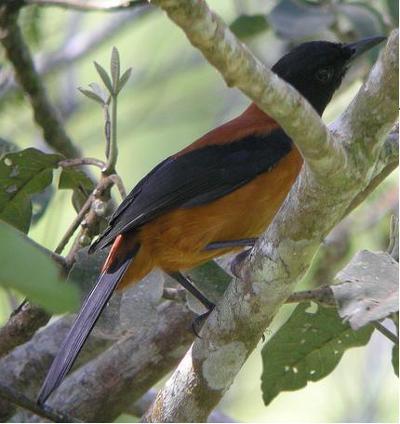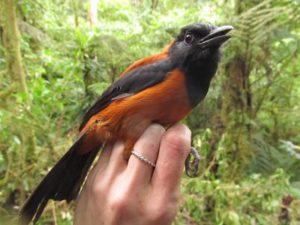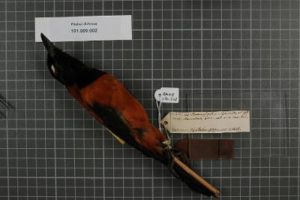By Maddox Brown
Salutations!
Never in my life have I ever imagined a day when a creature we might see every day—and that can soar through the sky blessing us with its beauty and elegance—would ever be even remotely poisonous. (I’m pretty sure most of you think the same way… don’t lie.)
Well, that innocent point of view might as well be thrown into the dumpster because recent discoveries have proved that such a poisonous creature does exist. You will be amazed yet a bit frightened at what this species of bird holds in store for any unlucky soul who crosses paths with it.
In 1989, while traversing through the lively and lush rainforests of New Guinea, scientist James Dumbacher suddenly encountered a new species of bird, entirely by accident. The bird, known at the time as the Pitohui, was trapped in a “mist net” (a variety of net mainly used by ornithologists and bat biologists to capture wild birds and bats for numerous research projects), and being the good Samaritan he is, Dumbacher released it from the net.
In doing so, however, he cut his hand, which developed a burning sensation. To try and ease the pain—since he had no disinfectant with him—he attempted to put the injured hand into his mouth. Unfortunately, this didn’t work. In fact, it even worsened the effect as now his lips and tongue began to burn and turned somewhat numb— (yikes!)
Due to what was happening to his mouth, he next experienced a really bad taste that affected his taste buds for the worse, so that everything he ate or drank afterwards tasted weird or peculiar to him. This effect lasted for hours. Since this was a rather odd event indeed, Dumbacher’s curiosity was peaked, so he devoted some time to researching more about this particular species to see if what he experienced was only connected to that one particular bird, or if the strange effects were produced by every member of this species.
In a rather brazen move undertaken in the name of science, he put some of the bird’s feathers in his mouth. Instantaneously, he developed the same burning sensation he’d had before. Interesting right?
The primary diet of this species consists of fruit, mainly figs of the genus ‘Ficus’, grass seeds, some insects, and other invertebrates as well as small vertebrates. Included among the vast amounts of invertebrates it’ll consume, are beetles, spiders, earwigs, flies, caterpillars, and ants. To add to, retain, or increase their toxicity, Pitohui often indulge in some fine Melyrid beetles. They would also participate in mixed-species foraging flocks, often acting as the flock leader.
The Hooded Pitohui is not classified as a species to be worried about in terms of endangerment or extinction. It was categorized as of ‘Least Concern’ on the IUCN Red List of Threatened Species, so you don’t have to worry about this species of bird dying off anytime soon… hopefully. It is a sub-species of bird found in the genus ‘Pitohui’, which is primarily found in New Guinea, not surprising there. The name also originates from the Papuan term, ‘rubbish’, which is why you would sometimes hear some Papuan people reference the name when eating something not to their liking or (obviously), rubbish. It is an average-sized songbird, spanning 22-23 centimeters in length and weighing about 65-76 grams on average, covered with black and orangish feathers. Due to its poisonous nature, it is avoided by hunters as well as a good amount of predators who know their limitations. Now, I can’t leave you guys hanging, let’s get into the root of the toxicity, shall we?
The species is now the first discovered species of toxic birds with toxins embedded in their skin. In 1992, it was reported that the Hooded Pitohui had some sort of neurotoxin called ‘Homobatrachotoxin’ in their tissues. Homobatrachotoxin is a member of a class of compounds collectively named ‘Batrachotoxins’ that can cause irreversible muscle paralysis due to their blocking of the action potential in nerves and muscles. Pretty scary. In fact, you can also spot the same type of neurotoxin only in Colombian “poison dart” frogs from the Phyllobates genus. However, this wasn’t the only type of toxin found on this bird; the Hooded Pitohui also had other batrachotoxins in its skin, including batrachotoxin-A cis-crotonate, batrachotoxin-A, and batrachotoxin-A 3’-hydroxypentanoate.
Bioassays (analytical methods to determine the concentration or potency of a substance) done on Pitohui tissue found that their skins and feathers contained the highest toxicity, while the skeletal muscles were the least potent parts of the birds. Of all the feathers, the breast and belly held the highest concentration of toxins. It is still up for debate what the function of the toxins is to the birds, and this has been the main question ever since its discovery. Some scientists say that the toxins act as a chemical repellent to predators and unwanted guests who want to do potential harm to its fragile structure. Others speculate that the purpose of the toxins is to lessen the effects of parasites. Both are very plausible reasons, and both could be right on the money too. While testing the toxins, lice were seen to avoid the highly toxic feathers of the Pitohui in favor of less toxic feathers or the feathers with no toxicity at all in them. Furthermore, lice living in toxic feathers were shown to survive a shorter amount of time than lice living in non-toxic feathers.
With this in mind, I hope the next time you travel to foreign lands and perhaps notice many new species of animals around you, you pause to take a second look at what you find yourself petting or admiring, for they might not be the kind of creature you can get very close to and survive.


